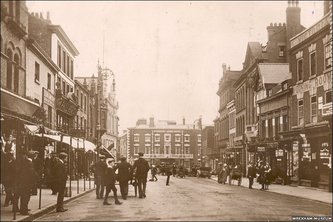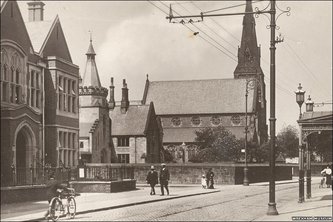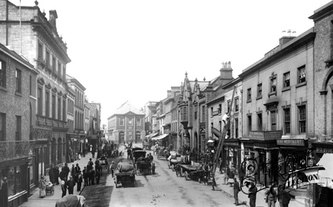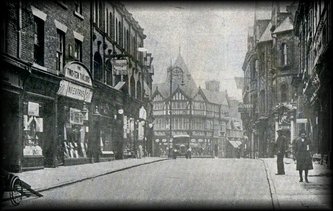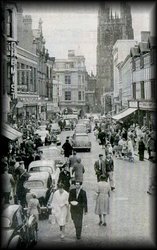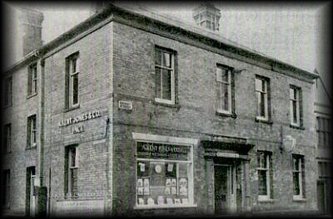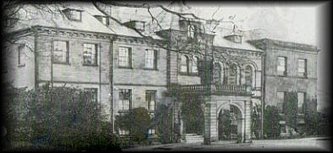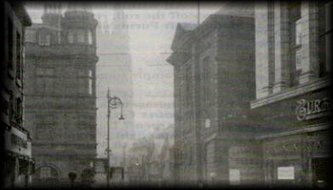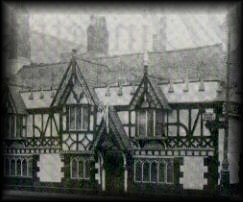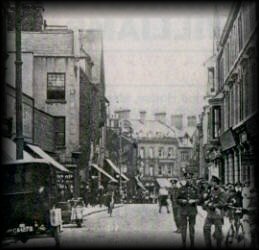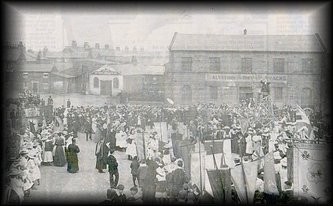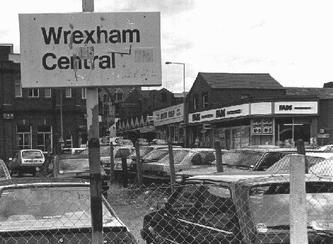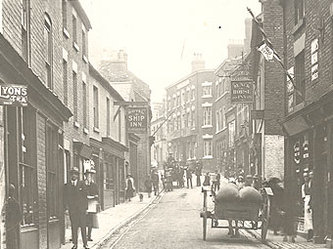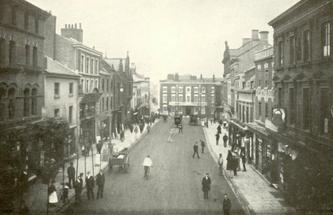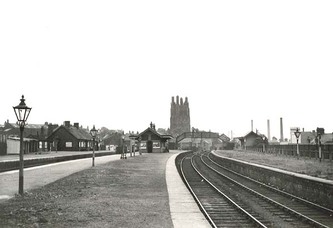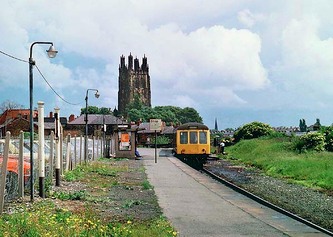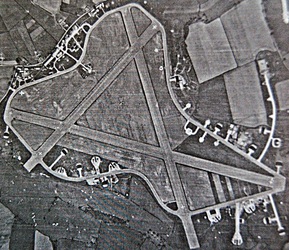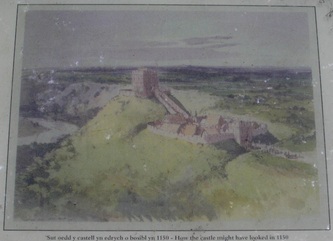"Ad astra per aspera."
Hi and welcome to my website, I hope you enjoy your visit, I hope to add loads of stuff as I go on. I will be adding loads more in the coming weeks/months/years so keep checking.
At the moment I have a section on the History of Wrexham, Buildings and Places of Wrexham Past and Present, Villages and Places around Wrexham, Broughton Community, The Moss Valley and Gatewen Hall.
Please feel free to email me here with any questions, advice or photos you would like to add.
The above photo is of my families bus company called Guy's buses.
Wrexham
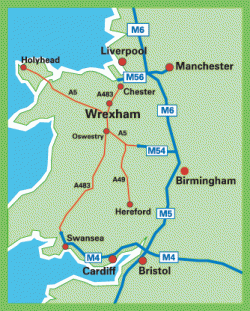
Wrexham is Wales' fourth largest town and is often described as the 'capital' of North Wales. Situated at the heart of the Welsh borderlands, Wrexham has the breathtaking scenery of North Wales, with its mountains, castles, historical sites and gardens, virtually on its doorstep. The lovely North Wales coast with its seaside resorts and spectacular coastline, is only a short drive away.
At the time of the United Kingdom Census 2001, Wrexham had a population of 42,576, and the wider Wrexham Urban Area, as defined by the Office for National Statistics, had a population of 63,084. The wider Wrexham county borough, which covers 50,500 hectares, has a population of over 130,000. The town is ranked as the 9th largest Town/Ciy in Wales, however its urban area is the 4th largest, after Cardiff, Swansea and Newport.
Wrexham is also ideally placed for easy access to city life, culture and entertainment. The major cities and towns of the North West and their airports and attractions are just a short drive away: Wrexham is only a 45 minute drive from Manchester and Manchester Airport, a 40 minute drive from Liverpool and only 15 minutes from the centre of Chester. The Shropshire border is also only a few minutes drive away.
Closer to home, there are plenty of retail, leisure and cultural experiences to keep residents and visitors interested when they come to Wrexham town centre. A fast developing centre of retail, Wrexham has all the major high street names as well as retail parks like Plas Coch offering a Sainsbury's supermarket, DIY stores and a DW Sports Gym, also located there is the Plas Coch Pub which is on the site of the old Plas Coch Farm. The shopping experience has expanded further with a new multimillion pound leisure and retail shopping centre "Eagles Meadow" which opened in 2009.
These developments complement the character of the town centre which has managed to retain many of its 'olde worlde' features such as narrow streets with their small specialist shops and traditional markets. Visitors will enjoy choosing from a wide range of coffee shops, cafes, pubs and clubs and exploring the rich cultural heritage to be found in its museums, library, theatre and churches.
Sports facilities are plentiful. The Waterworld complex with its extensive sport and leisure facilities is situated a few yards from the College as are Sports and Fitness Clubs such as DW and also the Queensway Sports Centre with its athletics track.
The Racecourse Football ground has undergone a substantial development and Wrexham is very proud of its football team.
There are many Heritage sites and Country Parks to visit and the famous National Trust property, Erddig is in Wrexham and attracts thousands of visitors each year. The Tourist and Information Centre in the town centre and only a few yards from the College, has all the latest information on where to stay and things to do and see.
Wrexham has one of the most modern and well equipped hospitals in Wales which has enjoyed a significant investment and increasing academic status with the University of Wales.
Wrexham is a modern industrial centre with over 300 companies, many of which are household names: Kelloggss, Sharp UK Ltd, Prysmian Cables, Hoya Lens and Brother. One of the main sites of Airbus UK is located a short distance away in Broughton.
The College liaises with many organisations from both the public and private sector to provide work based and staff development training. Students from the College are also able to take advantage of work experience with local companies and organisation
At the time of the United Kingdom Census 2001, Wrexham had a population of 42,576, and the wider Wrexham Urban Area, as defined by the Office for National Statistics, had a population of 63,084. The wider Wrexham county borough, which covers 50,500 hectares, has a population of over 130,000. The town is ranked as the 9th largest Town/Ciy in Wales, however its urban area is the 4th largest, after Cardiff, Swansea and Newport.
Wrexham is also ideally placed for easy access to city life, culture and entertainment. The major cities and towns of the North West and their airports and attractions are just a short drive away: Wrexham is only a 45 minute drive from Manchester and Manchester Airport, a 40 minute drive from Liverpool and only 15 minutes from the centre of Chester. The Shropshire border is also only a few minutes drive away.
Closer to home, there are plenty of retail, leisure and cultural experiences to keep residents and visitors interested when they come to Wrexham town centre. A fast developing centre of retail, Wrexham has all the major high street names as well as retail parks like Plas Coch offering a Sainsbury's supermarket, DIY stores and a DW Sports Gym, also located there is the Plas Coch Pub which is on the site of the old Plas Coch Farm. The shopping experience has expanded further with a new multimillion pound leisure and retail shopping centre "Eagles Meadow" which opened in 2009.
These developments complement the character of the town centre which has managed to retain many of its 'olde worlde' features such as narrow streets with their small specialist shops and traditional markets. Visitors will enjoy choosing from a wide range of coffee shops, cafes, pubs and clubs and exploring the rich cultural heritage to be found in its museums, library, theatre and churches.
Sports facilities are plentiful. The Waterworld complex with its extensive sport and leisure facilities is situated a few yards from the College as are Sports and Fitness Clubs such as DW and also the Queensway Sports Centre with its athletics track.
The Racecourse Football ground has undergone a substantial development and Wrexham is very proud of its football team.
There are many Heritage sites and Country Parks to visit and the famous National Trust property, Erddig is in Wrexham and attracts thousands of visitors each year. The Tourist and Information Centre in the town centre and only a few yards from the College, has all the latest information on where to stay and things to do and see.
Wrexham has one of the most modern and well equipped hospitals in Wales which has enjoyed a significant investment and increasing academic status with the University of Wales.
Wrexham is a modern industrial centre with over 300 companies, many of which are household names: Kelloggss, Sharp UK Ltd, Prysmian Cables, Hoya Lens and Brother. One of the main sites of Airbus UK is located a short distance away in Broughton.
The College liaises with many organisations from both the public and private sector to provide work based and staff development training. Students from the College are also able to take advantage of work experience with local companies and organisation
The History Of Wrexham
Prehistoric and Roman times
Approximately 8,000 years ago Mesolithic man ventured to what is now the Wrexham area. These people were hunter-gatherers and led a nomadic existence. They left little tangible evidence of their existence, save a number of small flint tools called Microliths that have been found in the Borras area.
A number of Neolithic (4300 - 2300 BC) stone axe heads have been found in Borras, Darland and Johnstown.
Two Bronze Age mounds are situated at Fairy Mount, Fairy Road and Hillbury on Hillbury Road. Both of these mounds lie within the grounds of Victorian properties in the south west of the town. It is likely that construction work within this area during the early 20th century eradicated other related features.
The area surrounding Wrexham is well served by several rivers, including the Clwyedog, Alyn and Gwenfro, all of which are tributaries of the Dee. These rivers would have served as highways for early man. Finds within the Alyn area reveal that trade was taking place along this river with places as far away as Ireland during the Bronze Age.
A number of Iron Age Hillforts also exist within the surrounding area, including Bryn Alyn (near Bradley), Y Gaer (near Pentre Broughton) and Y Gardden (near Ruabon).
At the time of the Roman conquest of Roman Britain, the area which Wrexham formed part of was held by a tribe called the Cornovii. The Cornovii held the lowland forests of Cheshire and Shropshire. Their tribal capital was at Wroxeter, near Shrewsbury. In 48 A.D the Roman Legions reached Wroxeter and then proceeded to attack a tribe called the Deceangli who were based in what is now Flintshire. Around 70 - 75 A.D the Legionary fortress of Deva was constructed (modern-day Chester) and for the next 300 years was the home of the Twentieth Legion.Evidence of Roman occupation can be found at nearby Holt, where a tile and pottery works were constructed on the banks of the River Dee and at Ffrith where the remains of buildings have been located. In recent years evidence of Roman occupation nearer the town centre, was found during the construction of the Plas Coch retail park. It is alleged that during the construction of the retail development in 1991, a hoard of Roman currency coins was discovered by workmen, however all of the coins disappeared. In 1995 further construction work on the site revealed traces of Roman field boundaries, hearths and a corn drying kiln. It is thought that these are the remains of a farmstead.
Approximately 8,000 years ago Mesolithic man ventured to what is now the Wrexham area. These people were hunter-gatherers and led a nomadic existence. They left little tangible evidence of their existence, save a number of small flint tools called Microliths that have been found in the Borras area.
A number of Neolithic (4300 - 2300 BC) stone axe heads have been found in Borras, Darland and Johnstown.
Two Bronze Age mounds are situated at Fairy Mount, Fairy Road and Hillbury on Hillbury Road. Both of these mounds lie within the grounds of Victorian properties in the south west of the town. It is likely that construction work within this area during the early 20th century eradicated other related features.
The area surrounding Wrexham is well served by several rivers, including the Clwyedog, Alyn and Gwenfro, all of which are tributaries of the Dee. These rivers would have served as highways for early man. Finds within the Alyn area reveal that trade was taking place along this river with places as far away as Ireland during the Bronze Age.
A number of Iron Age Hillforts also exist within the surrounding area, including Bryn Alyn (near Bradley), Y Gaer (near Pentre Broughton) and Y Gardden (near Ruabon).
At the time of the Roman conquest of Roman Britain, the area which Wrexham formed part of was held by a tribe called the Cornovii. The Cornovii held the lowland forests of Cheshire and Shropshire. Their tribal capital was at Wroxeter, near Shrewsbury. In 48 A.D the Roman Legions reached Wroxeter and then proceeded to attack a tribe called the Deceangli who were based in what is now Flintshire. Around 70 - 75 A.D the Legionary fortress of Deva was constructed (modern-day Chester) and for the next 300 years was the home of the Twentieth Legion.Evidence of Roman occupation can be found at nearby Holt, where a tile and pottery works were constructed on the banks of the River Dee and at Ffrith where the remains of buildings have been located. In recent years evidence of Roman occupation nearer the town centre, was found during the construction of the Plas Coch retail park. It is alleged that during the construction of the retail development in 1991, a hoard of Roman currency coins was discovered by workmen, however all of the coins disappeared. In 1995 further construction work on the site revealed traces of Roman field boundaries, hearths and a corn drying kiln. It is thought that these are the remains of a farmstead.
Middle Ages
In the early 8th century, Aethalbald King of Mercia, who reigned from 716 to 757, constructed Wat's Dyke; this 40-mile (64 km) long earthwork passes through the area and close to the western edge of the town.
Wrexham is not mentioned in the Domesday Book ; the first mention of it comes in 1161 by which time there was a Norman motte and bailey castle at 'Wristlesham', located in what is now 'Erddig Park', however, being well to the east of Offa's Dyke, there has probably been a settlement there since Saxon times. The castle was built by 'Hugh the Fat', who brought his Norman troops over the Welsh border from Chester to erect the castle, a similar edifice being constructed at Hodeslea(later Hoseley,now Marford.
King Edward 1st is on record as having briefly stayed at Wrexham during his expedition to suppress the revolt Madoc Ap Llewellyn in 1294. The town became part of the county of Denbighshire when it was created in 1536. Wrexham was divided into two distinct townships, Wrexham Regis (which was under the control of the King) and Wrexham Abbot(generally the older parts of the town, which originally belonged to Valle Crucis Abbey at nearby Llangollen). During the English Civil War, Wrexham was on the side of the Royalists as most Welsh gentry supported the king, even though local landowner Sir Thomas Myddelton, owner of Chirk castle gave his support to Parliament. Wrexham became the main town in the area and grew wealthy with its markets.
In the early 8th century, Aethalbald King of Mercia, who reigned from 716 to 757, constructed Wat's Dyke; this 40-mile (64 km) long earthwork passes through the area and close to the western edge of the town.
Wrexham is not mentioned in the Domesday Book ; the first mention of it comes in 1161 by which time there was a Norman motte and bailey castle at 'Wristlesham', located in what is now 'Erddig Park', however, being well to the east of Offa's Dyke, there has probably been a settlement there since Saxon times. The castle was built by 'Hugh the Fat', who brought his Norman troops over the Welsh border from Chester to erect the castle, a similar edifice being constructed at Hodeslea(later Hoseley,now Marford.
King Edward 1st is on record as having briefly stayed at Wrexham during his expedition to suppress the revolt Madoc Ap Llewellyn in 1294. The town became part of the county of Denbighshire when it was created in 1536. Wrexham was divided into two distinct townships, Wrexham Regis (which was under the control of the King) and Wrexham Abbot(generally the older parts of the town, which originally belonged to Valle Crucis Abbey at nearby Llangollen). During the English Civil War, Wrexham was on the side of the Royalists as most Welsh gentry supported the king, even though local landowner Sir Thomas Myddelton, owner of Chirk castle gave his support to Parliament. Wrexham became the main town in the area and grew wealthy with its markets.
Nineteenth and twentieth centuries
Wrexham was formerly one of the most industrialised areas in Wales. One of its main industries was brewing and there were several large breweries in the town, together with many smaller breweries situated at the back of local inns. Some of the more famous old breweries were the Albion, Cambrian, Eagle, Island Green, Soames and Willow. However, the most famous was the Wrexham Lager brewery which was built between 1881 and 1882 in Central Road. This was the first brewery to be built in the United Kingdom to produce lager beer. Another major producer, Border Breweries, was formed in 1931 by a merger of several of the existing smaller breweries. All commercial brewing in Wrexham has now ceased.
Bricks were produced in Abenbury on the outskirts of Wrexham.The brickworks was sited on both sides of the Abenbury Road.
Although coal mining was an important industry in the area, and provided employment for large numbers of Wrexham people, most of the mines were situated well outside the town. All of these mines are now closed. One legacy of Wrexham's industrial past was the Wrexham area's large and complex network of railways,the main branch being the Wrexham and Minera Branch,which supported the steelworks at nearby Brymbo Steel Mill and the Minera Limeworks. The rail network was torn up in the 1960s(and the Minera Branch in the early 1970s).
Wrexham began a period of depression: the many coal mines closed first, followed by the brickworks and other industries, and finally the steelworks(which had its own railway branch up until closure)in the 1980s. Wrexham faced an economic crisis, with residents anxious to sell their homes and move to areas with better employment prospects, but buyers were uninterested in an area where there was little employment. Many people were caught in a negative equity trap.
Wrexham was formerly one of the most industrialised areas in Wales. One of its main industries was brewing and there were several large breweries in the town, together with many smaller breweries situated at the back of local inns. Some of the more famous old breweries were the Albion, Cambrian, Eagle, Island Green, Soames and Willow. However, the most famous was the Wrexham Lager brewery which was built between 1881 and 1882 in Central Road. This was the first brewery to be built in the United Kingdom to produce lager beer. Another major producer, Border Breweries, was formed in 1931 by a merger of several of the existing smaller breweries. All commercial brewing in Wrexham has now ceased.
Bricks were produced in Abenbury on the outskirts of Wrexham.The brickworks was sited on both sides of the Abenbury Road.
Although coal mining was an important industry in the area, and provided employment for large numbers of Wrexham people, most of the mines were situated well outside the town. All of these mines are now closed. One legacy of Wrexham's industrial past was the Wrexham area's large and complex network of railways,the main branch being the Wrexham and Minera Branch,which supported the steelworks at nearby Brymbo Steel Mill and the Minera Limeworks. The rail network was torn up in the 1960s(and the Minera Branch in the early 1970s).
Wrexham began a period of depression: the many coal mines closed first, followed by the brickworks and other industries, and finally the steelworks(which had its own railway branch up until closure)in the 1980s. Wrexham faced an economic crisis, with residents anxious to sell their homes and move to areas with better employment prospects, but buyers were uninterested in an area where there was little employment. Many people were caught in a negative equity trap.
Present day
In the 1980s and 1990s, the Welsh Development Agency (WDA) intervened to improve Wrexham's situation: it funded a major dual carriageway called the A483 bypassing Wrexham and connecting it with Chester and Shrewsbury, which in turn had connections with other big cities such as Manchester and Liverpool. It also funded shops and reclaimed areas environmentally damaged by the coal industry. BHS, McDonalds, Game, Burger King, HMV, KFC and other major retail chains came to Wrexham, improving the area's employment prospects though many have now closed.
The biggest breakthrough was the Wrexham Industrial Estate, home to many manufacturing businesses including Kelloggs, JCB, Viilage Bakery and Tritech. There are also a number of other large industrial estates with companies such as Sharp, and Brother. The dual carriageway was extended halfway to the Estate in 2003, and is reached it by 2011.
The high land prices in the town mean that apartments and flats within the town centre have been built. This is leading to large apartment blocks being built in and around the town centre. In June 2003, the Caia Park estate in Wrexham was hit by riots, when local youths attacked several Iraqi Kurds living in the area, believing that they had been given preferential treatment due to their status as asylum seekers. Police were brought into the estate and petrol bombs and other missiles were hurled at them,causing a major riot.
In the 1980s and 1990s, the Welsh Development Agency (WDA) intervened to improve Wrexham's situation: it funded a major dual carriageway called the A483 bypassing Wrexham and connecting it with Chester and Shrewsbury, which in turn had connections with other big cities such as Manchester and Liverpool. It also funded shops and reclaimed areas environmentally damaged by the coal industry. BHS, McDonalds, Game, Burger King, HMV, KFC and other major retail chains came to Wrexham, improving the area's employment prospects though many have now closed.
The biggest breakthrough was the Wrexham Industrial Estate, home to many manufacturing businesses including Kelloggs, JCB, Viilage Bakery and Tritech. There are also a number of other large industrial estates with companies such as Sharp, and Brother. The dual carriageway was extended halfway to the Estate in 2003, and is reached it by 2011.
The high land prices in the town mean that apartments and flats within the town centre have been built. This is leading to large apartment blocks being built in and around the town centre. In June 2003, the Caia Park estate in Wrexham was hit by riots, when local youths attacked several Iraqi Kurds living in the area, believing that they had been given preferential treatment due to their status as asylum seekers. Police were brought into the estate and petrol bombs and other missiles were hurled at them,causing a major riot.
City status
Wrexham is now the largest settlement in North Wales, and has applied for city status several times, most recently in 2002 as part of the celebrations for the Golden Jubilee of Elizabeth II, along with Aberystwyth,Machynlleth,Newtown,Newport and St Asaph. In the end,Wrexham lost out to Newport,which has more than three times Wrexham's population.Wrexham county borough is among the smallest local authorities in north Wales by area. Although several attempts have been made to enlarge the local authority, other towns, such as Llangollen have rejected it, as there is a lot of "town rivalry" with neighbouring towns and cities, particularly Chester.
Wrexham is now the largest settlement in North Wales, and has applied for city status several times, most recently in 2002 as part of the celebrations for the Golden Jubilee of Elizabeth II, along with Aberystwyth,Machynlleth,Newtown,Newport and St Asaph. In the end,Wrexham lost out to Newport,which has more than three times Wrexham's population.Wrexham county borough is among the smallest local authorities in north Wales by area. Although several attempts have been made to enlarge the local authority, other towns, such as Llangollen have rejected it, as there is a lot of "town rivalry" with neighbouring towns and cities, particularly Chester.
Arts
Wrexham hosted the National Eisteddfod in 1888, 1912, 1933 and 1977, as well as an unofficial National Eisteddfod event in 1876. Wrexham has one theatre, the Grove Park Theatre. There is a multi-screen Odeon cinema in the Eagles Meadow shopping complex, just outside the town centre.
Wrexham hosted the National Eisteddfod in 1888, 1912, 1933 and 1977, as well as an unofficial National Eisteddfod event in 1876. Wrexham has one theatre, the Grove Park Theatre. There is a multi-screen Odeon cinema in the Eagles Meadow shopping complex, just outside the town centre.
Music
The main live music venue in Wrexham is Central Station, a club with a capacity of approximately 650, attracting touring bands from across the country. Since its opening in 2000 the venue has played host to hundreds of acts, including The Charlatans, the Scratch Perverts, Ash, The View, Mansun, Shed Seven, Hundred Reasons, Bloc Party, Grandmaster Flash, and Robert Plant, Soulfly, and many more. Another live music venue in Wrexham is the William Aston Hall at NEWI. It hosts concerts and live entertainment. This 900-seat venue has recently undergone extensive refurbishment, and is now designed to accommodate a range of events from conferences and exhibitions to theatrical performances and pop/rock concerts. Acts who have performed there in the past include Super Furry Animals, Love, Ray Davies, Rhos Male Voice Choir, Freddie Starr and Sweet.
The main live music venue in Wrexham is Central Station, a club with a capacity of approximately 650, attracting touring bands from across the country. Since its opening in 2000 the venue has played host to hundreds of acts, including The Charlatans, the Scratch Perverts, Ash, The View, Mansun, Shed Seven, Hundred Reasons, Bloc Party, Grandmaster Flash, and Robert Plant, Soulfly, and many more. Another live music venue in Wrexham is the William Aston Hall at NEWI. It hosts concerts and live entertainment. This 900-seat venue has recently undergone extensive refurbishment, and is now designed to accommodate a range of events from conferences and exhibitions to theatrical performances and pop/rock concerts. Acts who have performed there in the past include Super Furry Animals, Love, Ray Davies, Rhos Male Voice Choir, Freddie Starr and Sweet.
Media
Wrexham's daily newspapers include the North Wales Daily Post and Wrexham Evening Leader, the weekly free Wrexham Chronicle, and the weekly broadsheet Wrexham Leader, often known as the "Big Leader". The Wrexham Music Magazine is published monthly, and concentrates on the town's large music scene.
Four radio stations are based in the town - commercial stations Capital FM (serving most of North Wales, Cheshire and the Wirral) broadcast from studios on Mold Road in Gwersyllt, community station Calon FM is based within Glyndwr on Mold Road near the town centre and Wrexham FM provides online programming. BBC Cymru Wales also has a studio and newsroom for their radio and television services.
Wrexham's daily newspapers include the North Wales Daily Post and Wrexham Evening Leader, the weekly free Wrexham Chronicle, and the weekly broadsheet Wrexham Leader, often known as the "Big Leader". The Wrexham Music Magazine is published monthly, and concentrates on the town's large music scene.
Four radio stations are based in the town - commercial stations Capital FM (serving most of North Wales, Cheshire and the Wirral) broadcast from studios on Mold Road in Gwersyllt, community station Calon FM is based within Glyndwr on Mold Road near the town centre and Wrexham FM provides online programming. BBC Cymru Wales also has a studio and newsroom for their radio and television services.
Heritage
Wrexham's former police station on Regent Street, originally the barracks for the Royal Denbigshire Militia, is now home to Wrexham County Borough Museum. The museum has two galleries devoted to the history of the town and its surrounding communities. There is also a programme of temporary exhibitions, including last year an exhibition featuring the Mold Cape, the first time the Bronze Age treasure had returned to North Wales since its discovery in 1833.
Just to the west of the town, Bersham Heritage Centre and Ironworks tell the story of John Wilkinson, the 'Iron Mad' pioneer of the Industrial Revolution.
At the top end of the Clywedog Valley, about ten minutes' drive from Wrexham, Minera Lead Mines are the remains of the profitable lead industry that dates back to prehistoric times. Just to the east of Wrexham, there are the few remains of Holt Castle. The castle and the nearby late medieval bridge were the scene of constant skirmishes during the Civil War in the 17th century. The bridge was the entrance to North Wales and of vital strategic importance. Just south of Wrexham, Erddig, the National Trust property, was home to the Yorke family until 1973. Its last resident, Philip Yorke, handed over a house in need of restoration as years of subsidence caused by the workings of Bersham Colliery had caused a lot of damage. The house was not popular with Bersham miners as it stood on a pillar of coal and they had to work round it. Wrexham's mining heritage is nearly all gone. Bersham Colliery has the last surviving headgear in the North Wales coalfield. Just off the A483, on the edge of Wrexham, the Gresford Disaster Memorial stands witness to the 261 miners, 2 rescuemen and one surface worker killed by a series of explosions in the Gresford Collery in 1934.
Wrexham's former police station on Regent Street, originally the barracks for the Royal Denbigshire Militia, is now home to Wrexham County Borough Museum. The museum has two galleries devoted to the history of the town and its surrounding communities. There is also a programme of temporary exhibitions, including last year an exhibition featuring the Mold Cape, the first time the Bronze Age treasure had returned to North Wales since its discovery in 1833.
Just to the west of the town, Bersham Heritage Centre and Ironworks tell the story of John Wilkinson, the 'Iron Mad' pioneer of the Industrial Revolution.
At the top end of the Clywedog Valley, about ten minutes' drive from Wrexham, Minera Lead Mines are the remains of the profitable lead industry that dates back to prehistoric times. Just to the east of Wrexham, there are the few remains of Holt Castle. The castle and the nearby late medieval bridge were the scene of constant skirmishes during the Civil War in the 17th century. The bridge was the entrance to North Wales and of vital strategic importance. Just south of Wrexham, Erddig, the National Trust property, was home to the Yorke family until 1973. Its last resident, Philip Yorke, handed over a house in need of restoration as years of subsidence caused by the workings of Bersham Colliery had caused a lot of damage. The house was not popular with Bersham miners as it stood on a pillar of coal and they had to work round it. Wrexham's mining heritage is nearly all gone. Bersham Colliery has the last surviving headgear in the North Wales coalfield. Just off the A483, on the edge of Wrexham, the Gresford Disaster Memorial stands witness to the 261 miners, 2 rescuemen and one surface worker killed by a series of explosions in the Gresford Collery in 1934.
Religion
St Giles' Church is the parish church of Wrexham and includes a colourful ceiling of flying musical angels, two early eagle lecterns, a window by the artist Edward Burne-Jones and the Royal Welch Fusiliers chapel. In the graveyard is the tomb of Elihu Yale who was the benefactor of Yale University in New Haven, Connecticut, USA and after whom Yale College Wrexham is named. The tower of St. Giles is claimed as one of the 'Seven Wonders of Wales' and the tower of Yale University reflects its design.
The Catholic Cathedral of Our Lady of Sorrows, in Regent Street, is the main church of the Diocese of Wrexham, which extends over all of the north of Wales. Wrexham also has a number of non-denominational chapels and Churches scattered about the town.
The main Methodist church is in Brynyffynon, off Regent Street. Up until the 1970's the town was full of Welsh non-denominational Chapels and the attendance of these was far in excess of that of the Anglican Church in the town. In the past, Wrexham had a church with a spire much taller than the St Giles steeple dedicated and named after St Mark, but this was demolished as the building's foundations were in danger of collapse. A multi-storey car park named "St Marks" was erected on the site.
St Giles' Church is the parish church of Wrexham and includes a colourful ceiling of flying musical angels, two early eagle lecterns, a window by the artist Edward Burne-Jones and the Royal Welch Fusiliers chapel. In the graveyard is the tomb of Elihu Yale who was the benefactor of Yale University in New Haven, Connecticut, USA and after whom Yale College Wrexham is named. The tower of St. Giles is claimed as one of the 'Seven Wonders of Wales' and the tower of Yale University reflects its design.
The Catholic Cathedral of Our Lady of Sorrows, in Regent Street, is the main church of the Diocese of Wrexham, which extends over all of the north of Wales. Wrexham also has a number of non-denominational chapels and Churches scattered about the town.
The main Methodist church is in Brynyffynon, off Regent Street. Up until the 1970's the town was full of Welsh non-denominational Chapels and the attendance of these was far in excess of that of the Anglican Church in the town. In the past, Wrexham had a church with a spire much taller than the St Giles steeple dedicated and named after St Mark, but this was demolished as the building's foundations were in danger of collapse. A multi-storey car park named "St Marks" was erected on the site.
Sport
The town has a professional football team, Wrexham A.F.C., which competes in the National League. Currently managed by Dean Keates, the club has a rich history and is perhaps most notable for an FA Cup upset over Arsenal F.C. in 1992.
Despite the attempt to knock down the club's historic Racecourse Ground and replace it with a shopping development in 2005/06, the club survived after being bought by the fans, although the ground is now owned by Glyndwr university and Wrexham F.C have struggled in recent years with a spilt in fans. On Wednesday 23rd September, it was announced by Wrexham Football Club that an approach to invest in Wrexham AFC Limited was received by two extremely well-known individuals of high net worth who turned out to be Rob McElhenney, an American actor, director, producer and screenwriter, best known as the creator of It’s Always Sunny in Philadelphia and Ryan Reynolds, an award-winning Canadian actor, writer, producer and business entrepreneur whose credits include Marvel’s Deadpool. On Sunday 8th November, Mr. McElhenney and Mr. Reynolds put forward their vision for Wrexham AFC and proposal for members to vote on at a second Special General Meeting.
On 16 November 2020, it was confirmed that actors Ryan Reynolds and Rob McElhenney had successfully taken over the club after receiving the backing of the Wrexham Supporters Trust. A vote saw a landslide 98.6% of 2,000 members approving the proposed takeover.
The ground has in the past also served as the secondary home of the Llanelli Scarlets, one of the four Welsh professional rugby sides that compete in the Magners sponsored Celtic League. They would play, on average, two games per season there, though since the problems experienced by Wrexham FC during its period in administration, and uncertainty over the future of the ground, there were no Llanelli Scarlets games played there in season 2005-6 nor are any games scheduled for the 2006-7 Magners League season. Liverpool F.C. Reserves have also played their home fixtures here in the past, as do the Welsh international rugby team on occasion. It was also the home of the Crusaders Rugby team.
Education
Wrexham has a number of primary and secondary schools. It has just the one Welsh speaking school, that being Ysgol Morgan Llwyd. Recently, three of the largest secondary schools, St David's School, Ysgol Bryn Offa and The Groves High School were merged to create two larger "super schools", Ysgol Clywedog and Rhosnesni High. Wrexham has also become home to the first shared faith school in Wales in the form of St Joseph's. Coleg Cambria is the main post-16 education facility which opened a new state of the are buliding on Chester Road in 2020. Wrexham is also home to the newest University of Wales college, the North East Wales Institute of Higher Education (NEWI). This incorporates the North Wales School of Art and Design. NEWI is which now after being given full university status is now called Glyndŵr University.
Wrexham has a number of primary and secondary schools. It has just the one Welsh speaking school, that being Ysgol Morgan Llwyd. Recently, three of the largest secondary schools, St David's School, Ysgol Bryn Offa and The Groves High School were merged to create two larger "super schools", Ysgol Clywedog and Rhosnesni High. Wrexham has also become home to the first shared faith school in Wales in the form of St Joseph's. Coleg Cambria is the main post-16 education facility which opened a new state of the are buliding on Chester Road in 2020. Wrexham is also home to the newest University of Wales college, the North East Wales Institute of Higher Education (NEWI). This incorporates the North Wales School of Art and Design. NEWI is which now after being given full university status is now called Glyndŵr University.
Transport
Wrexham has various links to the transport network, with two railway stations and a large bus station. Wrexham General station provides direct rail services to Chester, Shrewsbury, Wolverhampton, Birmingham, Cardiff, Bangor and Holyhead while Wrexham Central station provides direct rail services to Hawarden, Shotton and Merseyside via the Borderlands Line.
A recent focus on road transport by the council has improved the bus travel in the Wrexham area, with most buses being low-floor and slightly elevated bus stops to allow people easier access to buses. A new bus terminal in Wrexham has been built. It is the largest in north Wales, featuring indoor shops and ambient music, along with a staffed information booth. The bus station serves local, regional and long-distance bus services. Wrexham is one of the first areas in the United Kingdom to adopt the use of American Bluebird school buses. 10 currently operate in the Wrexham area, transporting pupils to and from the schools and colleges.
Wrexham has various links to the transport network, with two railway stations and a large bus station. Wrexham General station provides direct rail services to Chester, Shrewsbury, Wolverhampton, Birmingham, Cardiff, Bangor and Holyhead while Wrexham Central station provides direct rail services to Hawarden, Shotton and Merseyside via the Borderlands Line.
A recent focus on road transport by the council has improved the bus travel in the Wrexham area, with most buses being low-floor and slightly elevated bus stops to allow people easier access to buses. A new bus terminal in Wrexham has been built. It is the largest in north Wales, featuring indoor shops and ambient music, along with a staffed information booth. The bus station serves local, regional and long-distance bus services. Wrexham is one of the first areas in the United Kingdom to adopt the use of American Bluebird school buses. 10 currently operate in the Wrexham area, transporting pupils to and from the schools and colleges.
Politics
Wrexham County Borough Council elects a mayor who serves for one year. The current mayor of Wrexham is Councillor Rob Walsh. Wrexham Council's website, is one of the leading council websites in the country. People who live under the jurisdiction of Wrexham County Borough Council are able to pay taxes, debts and other fees through the website. They can also access many other services, such as reporting crimes, submitting planning applications and applying for permits.
The Wrexham constituency elects members to the UK Parliament and the National Assembly for Wales. The constituency includes both the town and some of its outlying villages such as Gwersyllt, Llay, Marford and Rossett. The UK Parliament constituency of Wrexham has long been a safe seat for the Labour Party. Labour won the seat in all general elections from 1935 until 2019, when Conservative Sarah Atherton became the first woman elected to represent Wrexham.
Wrexham County Borough Council elects a mayor who serves for one year. The current mayor of Wrexham is Councillor Rob Walsh. Wrexham Council's website, is one of the leading council websites in the country. People who live under the jurisdiction of Wrexham County Borough Council are able to pay taxes, debts and other fees through the website. They can also access many other services, such as reporting crimes, submitting planning applications and applying for permits.
The Wrexham constituency elects members to the UK Parliament and the National Assembly for Wales. The constituency includes both the town and some of its outlying villages such as Gwersyllt, Llay, Marford and Rossett. The UK Parliament constituency of Wrexham has long been a safe seat for the Labour Party. Labour won the seat in all general elections from 1935 until 2019, when Conservative Sarah Atherton became the first woman elected to represent Wrexham.
Future plans
Wrexham has many major plans for the future. The WDA (Welsh Development Agency) (now disbanded), had earmarked Wrexham as a potential transport hub. The UK capital of culture for 2008, Liverpool, has also donated £100,000 to a study of electrification of the Wrexham to Bidston line, and a possible rail link to the North Wales coast line. This will open new rail links to the east, and the urban area of Liverpool. With house prices rising rapidly in this area, the council has made many plans for massive suburban housing estates to be built. One, near Ysgol Clywedog, will include a small shopping centre and another primary school. On 30 January 2006, it was announced that a new railway company, named the Wrexham Shropshire and Marylebone Railway (WSMR), had been formed. It planed to run a fast or high speed rail service from Wrexham, through Shrewsbury to London's Marylebone station however it closed on Saturday 28th January 2011.
Wrexham has many major plans for the future. The WDA (Welsh Development Agency) (now disbanded), had earmarked Wrexham as a potential transport hub. The UK capital of culture for 2008, Liverpool, has also donated £100,000 to a study of electrification of the Wrexham to Bidston line, and a possible rail link to the North Wales coast line. This will open new rail links to the east, and the urban area of Liverpool. With house prices rising rapidly in this area, the council has made many plans for massive suburban housing estates to be built. One, near Ysgol Clywedog, will include a small shopping centre and another primary school. On 30 January 2006, it was announced that a new railway company, named the Wrexham Shropshire and Marylebone Railway (WSMR), had been formed. It planed to run a fast or high speed rail service from Wrexham, through Shrewsbury to London's Marylebone station however it closed on Saturday 28th January 2011.
Pictures of Old Wrexham
|
Notable former residents
|
History of Wrexham Timeline
|
Below is a video from Youtube from 1991 taken driving through the town, it really shows the changes to the town centre in the last 20+ years.
